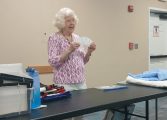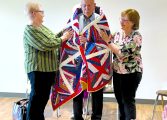Snow began by discussing the origins of watercolor. He said it was used by artists for sketching outdoor scenes, but has evolved into its own medium used for realism to abstract to impressionism. Snow is more realistic in his style, favoring farm scenes and country landscapes.
An award-winning member of the Central Virginia Watercolor Guild and the FAA, Snow believes practicing and painting every day for an hour or two will help to sharpen skill and the eye. But, he said, drawing is the foundation for art mediums and he suggested drawing often. He shared some other key points.
“Jump right in, don’t be afraid. Always plan ahead and do some miniature sketches before any paint touches the paper,” he said and added, “Start with a value sketch. Photos can be deceiving and don’t paint every detail you see in a photo.” He stressed that a good composition is a critical part of the artwork that sets apart brilliance and mediocrity.
He explained as he worked that he sets up the palette with cool colors and warm colors. In watercolor, the artist always works light to dark, building up the layers to form an image.
“It takes forethought and many find this difficult because they like to see the contrast right away,” Snow said.
“To prevent overworking a piece, work on it for half an hour to an hour. Time yourself – it forces you to move more quickly and to evaluate the process. I work an average of two hours and anything beyond that you make mistakes,” he said.
Supplies can be a personal preference for artists. Snow likes thick, flat brushes. Using a larger brush helps him simplify work and work faster. Though Snow uses sable, he said sable is expensive and thinks that synthetic is just as good. Using expensive brushes does not make you a better painter, he said.
Snow also uses other unconventional tools that create certain effects including a toothbrush for a splatter effect and a razor blade to scrape out color to create patterns.
In watercolor, the white of the paper is the only white that shows up in a painting. Snow is a purist and sticks to this rule, using the white of the paper for his whites and highlights. He also uses 300 lb. watercolor paper which is expensive but uses cold or hot press and 140 lb. for smaller pieces.
“Water will sit on the surface of hot press longer so it can be worked. Good for wet-on-wet technique,” he said.
While working on his painting of a flower, Snow suggested using more pigment for wet-on-wet technique and to keep practicing this elusive method.
Watercolor is one of the simplest mediums with minimal supplies but requires practice to master it. Snow was gracious and patient in his approach to teaching FAA members about a somewhat daunting medium to master. But after he was done, many walked away feeling more optimistic about giving watercolor another try.




